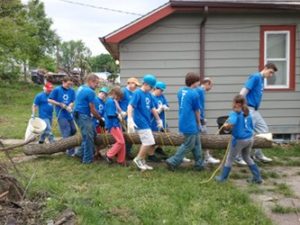Matt Rosenberg is a Rabbinical Student at American Jewish University in California and a NECHAMA volunteer. NECHAMA (Hebrew for comfort) is the Jewish community’s disaster response organization, based in the Twin Cities. Matt can be reached at rosenbergmatt@gmail.com.
 When I lived in Israel for a year, I distinctly remember witnessing the first blossoming of almond trees on the holiday known as Tu B’Shevat. For me, the coincidence of the first blossoms appearing and Tu B’Shevat was nothing short of a miracle for this minor holiday is known in the Jewish tradition as the “new year for trees.” It marks the beginning of the spring renewal that fills the land with the produce of Israel, as mentioned in Deuteronomy 8:8, a “land of wheat and barley, of vines, figs and pomegranates, a land of olive trees, and honey.”
When I lived in Israel for a year, I distinctly remember witnessing the first blossoming of almond trees on the holiday known as Tu B’Shevat. For me, the coincidence of the first blossoms appearing and Tu B’Shevat was nothing short of a miracle for this minor holiday is known in the Jewish tradition as the “new year for trees.” It marks the beginning of the spring renewal that fills the land with the produce of Israel, as mentioned in Deuteronomy 8:8, a “land of wheat and barley, of vines, figs and pomegranates, a land of olive trees, and honey.”
The ancient Israelites relied upon rain in its proper season to bring forth this produce from the land. Israel lacks rivers for irrigation so if there is too little rain, famine was the likely result.
Thousands of years ago the inconsistencies of nature could wreak havoc on society.
Even though we live in the twenty-first century, the same is true today.
Not enough rain leads to drought and too much rain leads to flooding. While we have more technology for controlling the impacts of these extremes, oftentimes, despite our best efforts, nature’s impact is profound.
In ancient times, Tu B’Shevat marked the end of the rains and the beginning of the planting season, a critical point in the agricultural calendar. Every region has that critical point, the too-many continuous days of rainfall; the point where high temperatures, low humidity, and Santa Ana winds will turn any spark into a conflagration; the time when the hurricane-force winds are projected to make landfall. We always live on that razor’s edge between serenity and chaos.
Tu B’Shevat provides us the opportunity to recognize the power of the divine and of nature on our planet. It is an ancient moment of transition that leads us from one season and into the first fleeting signs of another one beginning. It represents renewal and hope.
That hope exists in the hearts of those victims of disaster that NECHAMA helps throughout the year. Through its efforts to rebuild and repair, NECHAMA fills an important void in the disaster recovery process.
Happy New Year for the Trees!


